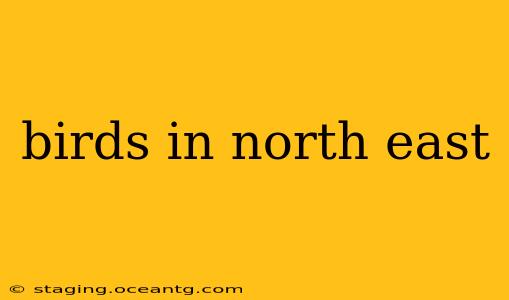The Northeast region of the United States boasts a stunning diversity of avian life, varying dramatically across its diverse habitats. From the bustling cities to the tranquil forests and coastlines, a rich tapestry of bird species calls this area home. This guide explores the fascinating world of Northeast birds, covering everything from common backyard visitors to rare migratory species. We'll delve into the unique characteristics of these feathered friends, their habitats, and the best times to spot them.
What are some common birds in the Northeast?
This is a broad question, as "common" depends on location and season. However, some consistently seen species across much of the Northeast include:
- American Robin: This iconic bird is a year-round resident in many areas, known for its cheerful song and bright reddish-orange breast.
- Northern Cardinal: A vibrant red male and a more subdued brownish-red female are easily identified, often seen flitting through backyard feeders.
- House Sparrow: While not native, this small brown bird is a very common sight in urban and suburban areas.
- Black-capped Chickadee: A tiny, energetic bird with a distinctive "chick-a-dee-dee-dee" call, frequently visiting bird feeders in winter.
- Downy Woodpecker: The smallest woodpecker in the region, it's easily recognized by its black and white plumage and habit of foraging on tree trunks.
Many other common birds can be found, depending on the specific habitat and time of year.
What are the best places to birdwatch in the Northeast?
The Northeast offers a plethora of incredible birding locations, catering to all skill levels. Some top spots include:
- Acadia National Park (Maine): Offers diverse habitats, from rocky coastlines to lush forests, attracting a wide variety of species.
- Green Mountain National Forest (Vermont): Provides excellent opportunities for observing forest birds, particularly warblers during migration.
- White Mountain National Forest (New Hampshire): Similar to Vermont's forests, offering great birdwatching possibilities.
- The coastlines of Maine, New Hampshire, and Massachusetts: These areas attract numerous seabirds and migratory shorebirds.
- Various state parks and wildlife refuges throughout the region: These protected areas often provide prime habitats and excellent opportunities for birdwatching.
What birds migrate through the Northeast?
The Northeast is a critical stopover point for many migratory birds traveling along the Atlantic Flyway. During spring and fall migrations, the region teems with a wide variety of warblers, flycatchers, vireos, and other songbirds. Some notable migratory species include:
- Various Warbler species: Many colorful warbler species pass through during migration, making spring a particularly exciting time for birdwatchers.
- Ruby-crowned Kinglet: A tiny bird with a surprisingly loud song, often found in forests and shrubs.
- Baltimore Oriole: A strikingly colored oriole with orange and black plumage, a favorite among bird enthusiasts.
- Various Flycatcher species: Several flycatcher species can be seen during migration.
What is the best time of year to birdwatch in the Northeast?
Spring and fall migrations are generally considered the best times to birdwatch in the Northeast, due to the high diversity of species passing through. However, winter offers opportunities to observe hardy resident species, while summer brings the excitement of observing nesting birds and their young.
What kind of equipment do I need for birdwatching in the Northeast?
While you can enjoy birdwatching with just your eyes, binoculars are highly recommended for a closer and more detailed view. A field guide to birds of the Northeast is also essential for identification. For more serious birdwatchers, spotting scopes and cameras with telephoto lenses can enhance the experience.
Where can I find more information about birds in the Northeast?
Numerous resources are available, including online databases (like eBird), local Audubon chapters, and books specializing in Northeastern bird identification. Many online forums and communities dedicated to birdwatching can also provide valuable insights and connect you with fellow enthusiasts.
This guide provides a starting point for exploring the rich avian diversity of the Northeast. Remember that responsible birdwatching involves respecting wildlife and their habitats. Happy birding!
